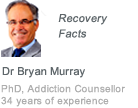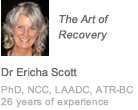Crack Cocaine Addiction
While the image of a cocaine user is generally that of a moneyed professional who likes to party, that of a crack cocaine addict is completely the opposite. Crack cocaine addicts are seen to be wrecked by their addiction – stealing and prostituting themselves for a ‘hit’ of ‘rock’ and among the dregs of society. Unlike most other drugs on the street, crack cocaine was designed with no interest in medicinal effects at all – it was developed by unscrupulous drug cartels to be highly addictive and to draw the users into the thrall of the dealers.
The origins of crack cocaine
Crack cocaine has never had a legitimate legal status in the United States, Canada or Europe, originating as it does from cocaine hydrochloride which has been illegal in the US since 1914 and across Europe since before WWII. It is believed that the origins of the crack form of cocaine date back to the mid 1980’s when a glut on the market caused the dealers to look for ways to reduce the volume of cocaine. They experimented with various ideas and one seemed to work as they wanted it to – they cooked it into a form that was more concentrated and extremely addictive.
Crack cocaine is far more effective in giving the addict a high (the sense of euphoria) as the smoked form is absorbed directly into the bloodstream via the oxygen-Blood transfer process in the lungs. Cocaine in its more original form is sniffed or ‘Snorted’ which will pass into the bloodstream less immediately and has the effect of a stimulant on the nervous system.
Crack cocaine addiction: usage and effects
Crack cocaine is generally smoked using a ‘Pipe’ or ‘Bottle’.
- The pipe takes the smoke directly into the addicts mouth and lungs and can burn the mouth or throat of the addict
- The bottle will contain water to cool the smoke before it hits the mouth of the crack addict in the same way that a Shisha Pipe is used to smoke tobacco in Arab climes
- Crack can be snorted although this is less usual and there are few actual examples of this
- The crack cocaine addict can inject the drug intravenously although, again, this is rare
The high from a hit of crack cocaine is short – typically 5 to 15 minutes – and the effect is so intense that another ‘hit’ is craved almost immediately after the effects wear off.
Crack cocaine delivers a very intense stimulation to the Dopamine transmitters in the brain, directly affecting the nervous system. This is the area of the brain that is most closely associated with pleasure and with movement and it is this stimulation to the pleasure centers that gives crack cocaine its biggest impact. The craving for the drug is as a direct result of stimulation of the reward system – literally, the brain gives a treat to the addict out of all relation to the toxic effects of the drug.
The short term effects are many:
- Increased blood pressure and pulse rate – similar to the body’s reaction to impending orgasm
- Constriction to the peripheral blood vessels often resulting in numbness and tingling
- Dilated pupils
- Intense feelings of euphoria and happiness
- Lack of appetite
- A feeling of impending paranoia and anxiousness
- Depression – most normally experienced after the ‘hit’ has worn off and leading to
- Intense craving for another hit of the drug
Longer term effects are similarly complex and varied:
- Crack cocaine addicts can suffer from severe depression
- They will often be irritable and suffer mood swings and will develop paranoia
- Addicts can be very aggressive, especially when they need another dose
- They can often suffer auditory and visual hallucinations coupled with the sense that they are physically experiencing bugs crawling all over their body
- Heart problems are common, especially arrhythmia, strokes and cardiac arrest
- Brain seizures are common
- Infertility is a common side effect of long term crack cocaine addiction
- Death – there are many risks to crack cocaine addiction that will kill
One common side effect of crack cocaine addiction is a loss of self-worth. The addict loses all consideration of themselves as an individual of value and focuses entirely on satisfying the need for the drug ahead of any other needs.
It is not uncommon to find long term addicts that are virtually starved due to a lack of interest in anything other than the drug and the stimulation of the pleasure centers it can deliver.
Profile of crack cocaine addicts
Crack cocaine addicts may come from any strata of society but there is a commonly degrading impact on the addicts that tends to bring them down to the same base, eventually.
Cocaine has had a reputation for many years as the drug of choice for high-flyers, especially bankers and musicians. It has an accepted profile as the drug that will drive aggression and confidence, but the other side of cocaine is its analgesic effect and this is much stronger in the form of crack. The side-effects and general behavior of crack addicts had led to them being generally viewed as desperate and at the bottom level of society.
Crack is also popular with the music industry where it is often mixed with heroin or morphine to maximize its effect. Many musicians have ended up severely addicted, often through only occasional use.
When crack cocaine first hit the market it was seen as a drug for the young and desperate but its effect can be seen in people of all ages today and it is even seen in newborn babies – Crack Babies – who are born of Crack Mothers
Recognizing crack cocaine addiction
Crack cocaine addicts tend to group together in ‘Crack Dens’ where they will share crack pipes and bottles.
The individual addicts will buy ‘rocks’ from their dealer and then bring the purchase back to the ‘Den’ where they will normally consume their own rocks – it is unusual for crack addicts to share their drug, they only share the methods and paraphernalia of ingestion.
The most common signs that someone is using or addicted to crack cocaine are:
- Irritability and general anxiety
- A glassy gaze and a faraway look
- Aggressive and confrontational behaviours
- Constant looking around – trying to see who or what is after them
- Massive decrease in weight and appetite
- Rambling and often incoherent speech
- Licking lips and a dry and hacking cough
- Great thirst and need for water
- Hallucinations
- Depression and mood swings
Additionally they will be evasive and will duck direct questions, they will make regular short trips away to get high and show a change in their behavior when they have had a ‘hit’.
Treating crack cocaine addicts
In addition to their physical addiction to the drug, a crack cocaine addict may well have severe physical and emotional problems.
There is, as with most drugs, a variety of different approaches to rehab from crack cocaine addiction and these will vary depending on the addicts length of time as an addict and his/her continuing reliance on the drug. Sudden cessation of the drugtaking may well lead to psychotic episodes as well as severe physical reactions including cramps and muscles spasms, vomiting and uncontrollable shaking.
There is no therapy drug that can be offered as an alternative to crack cocaine so medical intervention will almost always be required to support the addict through the physical stages of withdrawal from their addiction.
Holistic treatment and support is almost always a big help in the prevention of relapse, as well as looking at the underlying problems and pressures that may have started the addict on their particular road to the bottom. The most effective treatments will include Yoga to help repair their mental state as well as acupuncture and acupressure to help their bodies with the repair process.
Professional and peer group counseling is often very helpful and advice and emotional support are an essential part of the treatment. If family and friends are still in touch and have the strength to help the addict then that extra level of acceptance and support can make the difference between success and failure, which with crack cocaine addiction can be the difference between life and death.
It is often the case with crack cocaine addicts that they were hooked very early on in their drug career and the fear of relapse can be a powerful tool towards a final cure of their addiction. Additionally, many addicts lack self-confidence, self-belief and a vision of a future living drug-free, so an holistic approach that helps them to deal with these, and many other, issues is an essential part of treatment and recovery.












